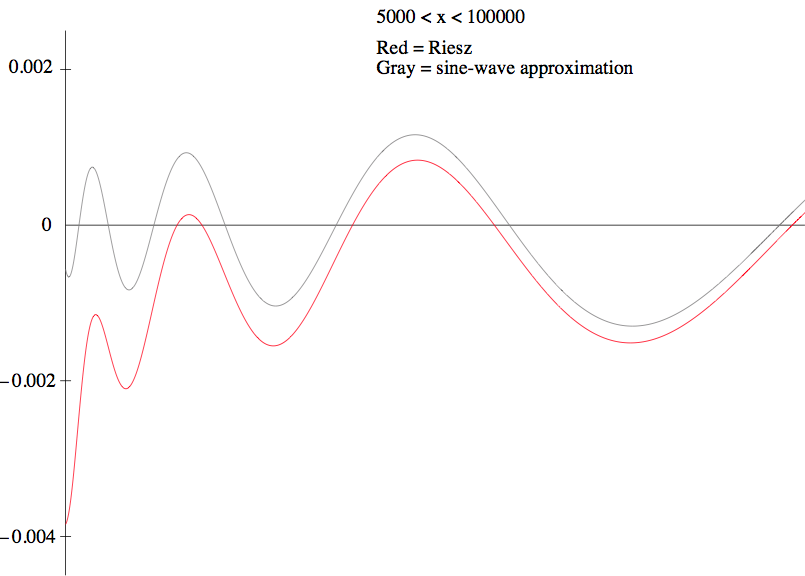The Wikipedia page
on the Riesz function which Barry Cipra cited has a link to a
paper
by Wilf showing that there are infinitely many real $x$ where
the function vanishes, though rather sparse: the number of such $x \geq X$
is asymptotically proportional to $\log X$. The function certainly
does not approach zero as $x \rightarrow \infty$;
even the estimate $f(x) = o(x^{1/4+\epsilon})$
would be equivalent to the Riemann hypothesis, as Riesz noted
in his original 1916 paper in Acta Math.
Numerically, the first few zero crossings beyond $1.15$ are at about
$19326.551$, $22521.798$, $51868.607$ if I did this right.
Here's a plot for $x \in [5\cdot 10^3, 10^5]$, comparing $f(x)$
with the main term
$$
{\rm Re}\left(
\frac {\Gamma\left(1 - \frac{\rho_1}{2}\right)}{\zeta'(\rho_1)}
x^{\rho_1/2}
\right)
$$
in the asymptotic expansion of $f(x)$ for large $x$.
 (source)
(source)
Here $\rho_1 = \frac12 + 14.1347\ldots i$ is the first
complex zero of the Riemann $\zeta$ function.
The factor $x^{\rho_1/2}$ oscillates with amplitude $x^{1/4}$.
The coefficient is small (absolute value about $7.775 \cdot 10^{-5}$)
because of the complex Gamma factor; further complex zeros provide
additional terms, but the $\rho_2$ term is already smaller by a factor of
almost $300$, and further terms should be smaller yet, assuming
no $\zeta$ zeros get very close to each other (let alone collide
or worse). The discrepancy between the two plots is accounted for almost entirely by
the first trivial zero of $\zeta$ at $-2$, which gives a term
$1/\left(2\zeta'(-2)x\right)$ that is asymptotically negligible but makes
$f(x)$ negative for $1.15 < x < 5000$. It takes a long time for
the growth of $x^{1/4}$ to overcome the small Gamma factor:
$\left|\phantom.f(x)\right|$ first exceeds $1$ around $x = 10^{19}$.
The asymptotic expansion comes from the contour-integral formula
$$
f(x) = \frac1{2\pi i}
\int_{c-i\infty}^{c+i\infty} \frac{\Gamma(s+1)}{\zeta(-2s)} x^{-s} ds
$$
with $-1 < c < -1/2$. NB the denominator really is $\zeta(-2s)$,
not $\zeta(+2s)$; we encounter zeros of $\zeta$ by moving the contour
to the right. The Wikipedia page gives this formula but without
the factor of $(2\pi i)^{-1}$ $-$ maybe somebody reading this can fix
that error.
To compute $f(x)$ numerically, we can't quite use the formula
$$
f(x) = \sum_{n=1}^\infty \mu(n) \frac{x}{n^2} e^{-x/n^2}
$$
because it doesn't converge fast enough to locate the large zeros.
Instead, by applying the same trick to the sum over (say) $k \geq 4$
instead of $k \geq 1$ we get an expansion such as
$$
f(x) = \frac{6x}{\pi^2} - \frac{90x^2}{\pi^4} + \frac{945x^3}{2\pi^6}
+ \sum_{n=1}^\infty \mu(n) \frac{x}{n^2}
\left( \exp\left(\frac{-x}{n^2}\right)
- 1 + \frac{x}{n^2} - \frac{x^2}{2n^4}
\right)
$$
which was used to compute $f(x)$ to enough accuracy to draw the
plot shown above. For large $x$ this technique still requires
$x^{1/2 + \epsilon}$ terms. It may be barely feasible to compute $f$
this way for $x \approx 10^{19}$ large enough to see $\left|\phantom.f(x)\right|>1$;
but the asymptotic expansion using the first handful of zeta zeros
should be much better for this purpose.

